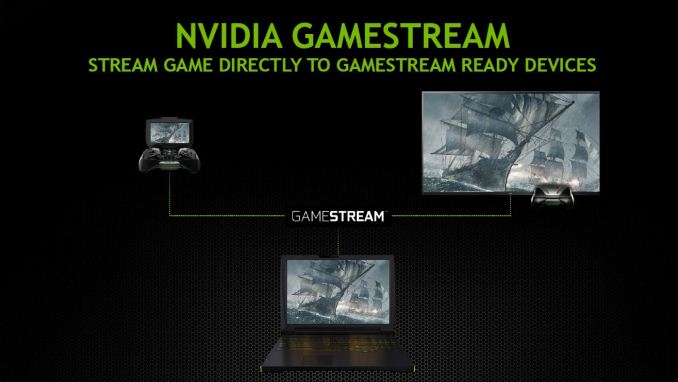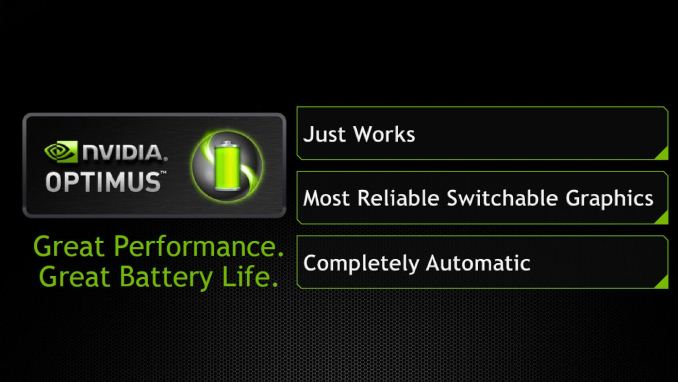NVIDIA’s GeForce 800M Lineup for Laptops and Battery Boost
by Jarred Walton on March 12, 2014 12:00 PM ESTOther Features: GameStream, ShadowPlay, Optimus, etc.
Along with Battery Boost, the GTX class of 800M GPUs will now also support NVIDIA’s GameStream and ShadowPlay technologies, again through NVIDIA’s GeForce Experience software. Unlike Battery Boost, these are almost purely software driven solutions and so they are not strictly limited to 800M hardware. However, the performance requirements are high enough that NVIDIA is limiting their use to GTX GPUs, and all GTX 700M and 800M parts will support the feature, along with the GTX 680M, 675MX, and 670MX. Basically, all GTX Kepler and Maxwell parts will support GameStream and ShadowPlay; the requirement for Kepler/Maxwell incidentally comes because GameStream and ShadowPlay both make use of NVIDIA’s hardware encoding feature.
If you haven’t been following NVIDIA’s software updates, the quick summary is that GameStream allows the streaming of games from your laptop/desktop to an NVIDIA SHIELD device. Not all games are fully supported/optimized, but there are over 50 officially supported games and most Steam games should work via Steam’s Big Picture mode. I haven’t really played with GameStream yet, so I’m not in a position to say much more on the subject right now, but if you don’t mind playing with a gamepad it’s another option for going mobile – within the confines of your home – and can give you much longer unplugged time. GameStream does require a good WiFi connection (at least 300Mbps 5GHz, though you can try it with slower connections I believe), and the list of GameStream-Ready routers can be found online.
On a related note, something I'd really like to see is support for GameStream extended to more than just SHIELD devices. NVIDIA is already able to stream 1080p content in this fashion, and while it might not match the experience of a GTX 880M notebook running natively, it would certainly be a big step up from lower-end GPUs and iGPUs. Considering the majority of work is done on the source side (rendering and encoding a game) and the target device only has to decode a video stream and provide user I/O, it shouldn't be all that difficult. Take it a step further and we could have something akin to the GRID Gaming Beta coupled with a gaming service (Steam, anyone?) and you could potentially get five or six hours of "real" gaming on any supported laptop! Naturally, NVIDIA is in the business of selling GPUs and I don't see them releasing GameStream for non-NVIDIA GPUs (i.e. Intel iGPUs) any time soon, if ever. Still, it's a cool thought and perhaps someone else can accomplish this. (And yes, I know there are already services that are trying to do cloud gaming, but they have various drawbacks; being able to do my own "local cloud gaming" would definitely be cool.)
ShadowPlay targets a slightly different task, namely that of capturing your best gaming moments. When enabled in GFE, at any point in time you can press Alt+F10 to save up to the last 20 minutes (user configurable within GFE) of game play. Manual recording is also supported, with Alt+F9 used to start/stop recording and a duration limited only by the amount of disk space you have available. (Both hotkeys are customizable as well.) The impact on performance with ShadowPlay is typically around 5%, and at most around 10%, with a maximum resolution of up to 1080p (higher resolutions will be automatically scaled down to 1080p).
We’ve mentioned GeForce Experience quite a few times now, and NVIDIA is particularly proud of all the useful features they’ve managed to add to GFE since it first went into open beta at the start of 2013. Initially GFE’s main draw was the ability to apply “optimal” settings to all supported/detected games, but obviously that’s no longer the only reason to use the software. Anyway, I’m not usually much of a fan of “automagic” game settings, but GFE does tend to provide appropriate defaults, and you can always adjust any settings that you don’t agree with. AMD is trying to provide a similar feature via their Raptr gaming service, but by using a GPU farm to automatically test and generate settings for all of their GPUs NVIDIA is definitely ahead for the time being.
NVIDIA being ahead of AMD applies to other areas as well, to varying degrees. Optimus has seen broad support for nearly every laptop equipped with an NVIDIA GPU for a couple years now, and the number of edge cases where Optimus doesn’t work quite as expected is quite small – I can’t remember the last time I had any problems with the feature. Enduro tends to work okay on the latest platforms as well, but honestly I haven’t received a new Enduro-enabled laptop since about a year ago, and there have been plenty of times where Enduro – and AMD’s drivers – have been more than a little frustrating. PhysX and 3D Vision also tend to get used/supported more than the competing solutions, but I’d rate those as being less important in general.













91 Comments
View All Comments
Freakie - Wednesday, March 12, 2014 - link
Not only in time for back-to-school, but in time for Broadwell. The power improvements of Broadwell + Maxwell at the very high end will be an incredibly refreshing change in gaming-laptop battery life.willis936 - Wednesday, March 12, 2014 - link
What's the timeframe for laptops showing up with these? A P34G with a GTX 860M (and hopefully a 16GB option) would be great before summer.bakedpatato - Wednesday, March 12, 2014 - link
Couple of outlets are running pieces on the "New Razer Blade 14", it has a 3200 x 1800 touch screen and indeed does have a 870m while the Blade Pro indeed has a 860mjasonelmore - Wednesday, March 12, 2014 - link
wtf the pro has a less powerful GPU in a much bigger chassis?jcompagner - Wednesday, March 12, 2014 - link
So now we will get a many nice and light and thin 17" laptops?Currently the only 1 i can by in The Netherlands is the MSI Stealth. I don't know any other. So i guess i just have to wait until the refresh of the Stealth (that i guess will have a 8xxM in side it)
But it would be nice to have way more options.. (for example a 17" with a resolution between 2k and 4k)
Aikouka - Wednesday, March 12, 2014 - link
Hm, I think the only disappointing factors are the use of Kepler and Maxwell parts (although not surprising) and the lack of distinguishing between the two architectures at the 860M level. However, I am looking forward to coverage of 860M (Maxwell) parts as I think that will finally be a good sweet spot for me. I have an aging gaming laptop (Dell M1530 with an M8600 GT), and I've grown very used to my ASUS Zenbook... especially its weight (or the lack thereof). So, I'm hoping for a (relatively!) light-weight laptop that has some decent gaming power under the hood.willis936 - Wednesday, March 12, 2014 - link
Kepler? How about that Fermi SKU? They have to be blowing the dust off of some old chips to still be selling those. Really the most disappointing thing about the 800 series so far is the fact that there still is no word on desktop parts. As most people are saying they're likely waiting for TSMC 20nm. That is a long gap. The entire desktop gaming GPU cycle has been shifted half a year because of it. I can't imagine nvidia and amd expect to get "back on track" by releasing the 900 series parts a few months after the 800 series.schizoide - Wednesday, March 12, 2014 - link
The 750Ti (and thus 860m) still doesn't match the 7870/660 class GPUs in current-gen consoles and thus isn't a really viable enthusiast gaming platform. The870m is a closer fit, and the 880m definitely does it, but those will be much more expensive. We're so dang close to xbone/PS4-class performance in mainstream laptops, it hurts.
JarredWalton - Wednesday, March 12, 2014 - link
You can't just look at the CUDA core counts -- the consoles are using AMD chips for one, and AMD shader cores have almost always been "slower" individually than NVIDIA shader cores. I suspect the GTX 750 Ti will give the PS4 and XBOne a run for the money in GPU performance. Couple it with a decent CPU and the only thing really holding us back on PCs is the OS and the need to support "infinity" different hardware configurations.schizoide - Wednesday, March 12, 2014 - link
I'm not looking at core counts alone, all the various game tests have shown the 750Ti to be slower than the 7870 and the 660, which are roughly equivalent to current-gen consoles.